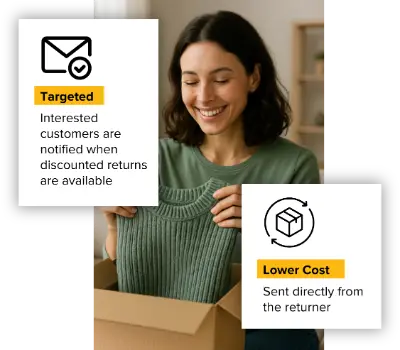October 2023 Seller Fulfilled Prime Guidelines – What’s New, What’s Changed, What’s Important?

Last updated on August 15, 2023

In this article
 19 minutes
19 minutes
- No time to read? No problem! Watch this quick video summary instead.
- Program Requirements and Criteria
- Previous Expectations
- New Expectations
- Previous Expectations
- New Expectations
- No More Protection Through Buy Shipping Usage Available
- Previous Expectations
- New Expectations
- More flexibility in picking carriers and services
- Previous Expectations
- New Expectations
- Less Hassle for Merchants in Meeting This Metric
- Previous Expectations
- New Expectations
- Prime Badge Available Nationwide For all SKUs, but with the Caveat of Higher Shipping Fees
- Previous Expectations
- New Expectations
- Delivery Speed Expectations Increase Across Every SKU
- Previous Expectations
- New Expectations
- Time to Enrollment Shortens for Some Sellers, While Others May No Longer Be Eligible
- Previous Expectations
- New Expectations
- Amazon Gives Sellers More Chances, but the Road Back is Extremely Tough
- Previous Expectations
- New Expectations
- Return Costs Rise for Sellers - Even When the Onus is on the Buyer
Watch On-Demand Webinar: Amazon SFP – How To Sell and Win in 2023
On August 8, 2023, Amazon announced a wide range of changes to the criteria it expects sellers to meet on its Seller Fulfilled Prime program. The company introduced new requirements, while updating its expectations from merchants across other metrics. These include on-time delivery, valid tracking, nationwide delivery, delivery speed, free returns and program fees. Amazon has also removed the use of the On-Time Shipment metric and no longer requires the use of its Buy Shipping services.
No time to read? No problem! Watch this quick video summary instead.
In this article, we breakdown each criteria – explaining the old requirements and the new ones that will go into effect on October 1, 2023. We also explain the impact we expect sellers to face from each of these changes.

Program Requirements and Criteria
On-Time Shipment (OTS)
The On-Time Shipment Rate is defined by Amazon as the number of units that shipped on or before the Promised Ship Date / Total No. of Shipped SFP Units.
Amazon tracks this metric based on when the carrier scan occurs.
|
Old SFP Requirements
|
New SFP Requirements
|
Impact on Sellers
|
|---|---|---|
|
> 99% OTS rate expected.
|
Amazon is no longer going to track this metric on Seller Fulfilled Prime. The company claims that it is doing this to provide greater flexibility of shipping services and carrier options.
|
Positive (but only if you have the right technology in place!).
|
Previous Expectations
If an order is received before the cut-off time Mon-Fri and Sat/Sun (whichever the seller prefers to enable), carrier scan must occur the same day.
A carrier scan must occur the next day if an order is received after the cut-off time.
This is the most important metric in the current Seller Fulfilled Prime requirements.
New Expectations
Sellers will no longer be judged on this metric.
You don’t have to ship the same day if shipping tomorrow is optimal
Under the current Seller Fulfilled Prime guidelines, Amazon requires sellers to ensure a carrier scan is conducted the same day for all orders received before the cut-off time.
There are situations where this rule forces sellers to unnecessarily use expensive air shipping, at the expense of more economical services. It’s best to understand this with an example:
Let’s imagine you’re a seller with 2 warehouse locations – one in Los Angeles and the other in New York. Imagine that you receive an order from a customer in Connecticut at 3PM ET on a Monday:
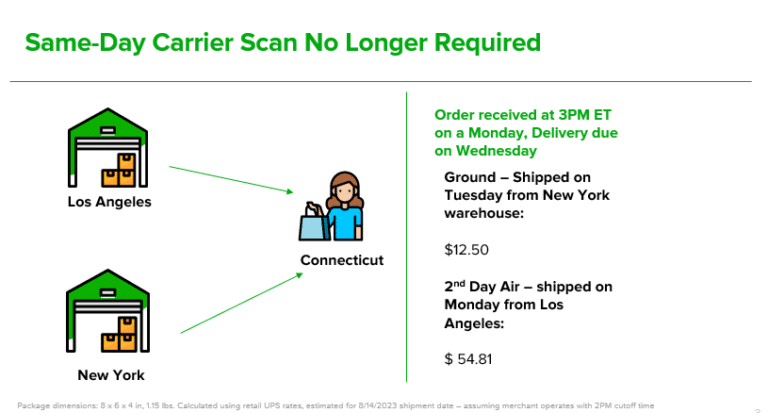
Ideally, you would like to use an economical ground service which can reach the customer in time by fulfilling the order from your New York warehouse. However, because it is past the cutoff time in New York, but before the cutoff time in Los Angeles, Amazon will expect a carrier scan that same day. The only way for you to ship from Los Angeles and deliver to the customer by the promised date is through an expensive air shipping service.
However, with carrier scans no longer required on the same day, you can now choose to ship the next day from your New York warehouse through a service like UPS ground – which is 3.5X cheaper than the air service. Such cost savings can only be achieved, however, if you have the right technology in place. Your shipping software needs to intelligently compare warehouse locations, carriers and shipping services to determine the most economical option to use, which still satisfies the customer expectation.
Slash Your Fulfillment Costs by Up to 30%
Cut shipping expenses by 30% and boost profit with Cahoot's AI-optimized fulfillment services and modern tech —no overheads and no humans required!
I'm Interested in Saving Time and MoneyOn-Time Delivery (OTD)
The On-Time Delivery Rate is defined as Number of Units delivered on or before the Promise Date (which the customer sees at the time of checkout) / Total No. of SFP Units Shipped.
Amazon tracks this metric based on 2 parameters – the delivery date committed to the customer when they checkout, and when the package is actually delivered at their address.

Previous Expectations
Under the old program, Amazon heavily pushed the use of its Buy Shipping Service. Amazon might also believe that only the services on Buy Shipping are capable of meeting the delivery promises made to customers.
Therefore, it was only in cases when labels were bought off of Buy Shipping that sellers were held to the high bar of 97% on-time delivery.
New Expectations
This becomes the most important metric under the new Seller Fulfilled Prime requirements.
Amazon is also going to minimize the provision of “Promise Extensions” (in some cases, the customer is shown a later delivery date because Amazon factors in buffer time due to logistical challenges at the seller’s end).
They encourage sellers to begin by looking at their On-Time Delivery Rate for orders without Promise Extensions (to get a sense of their ‘true’ order fulfillment levels).
No More Protection Through Buy Shipping Usage Available
While the 93.5% on-time expectation is a reduced one, which is more favorable for sellers (they don’t have to be perfect every time), this metric could still work against them. The major reason for this is that sellers now lose the protection that the previous program afforded – so long as they bought the label on Amazon Buy Shipping, and performed the carrier scan in time, they could not be held accountable for any delays in order delivery due to carrier issues. Now, it no longer matters whether the label was bought through Buy Shipping or if a carrier scan occurred in time – sellers must meet the 93.5% benchmark. The biggest contributor to making it happen are the shipping carriers. The biggest criteria by which Amazon measures success on the program is now in the hands of a factor that the seller cannot entirely control – the ability of the shipping carriers to execute operations smoothly and without disruption.
Buy Shipping Usage
Amazon Buy Shipping is Amazon’s system through which sellers and merchants can purchase shipping labels to fulfill their orders.
The Buy Shipping Usage % is defined as the Number of Units for which labels were bought with Buy Shipping / Total No. of SFP Units Shipped
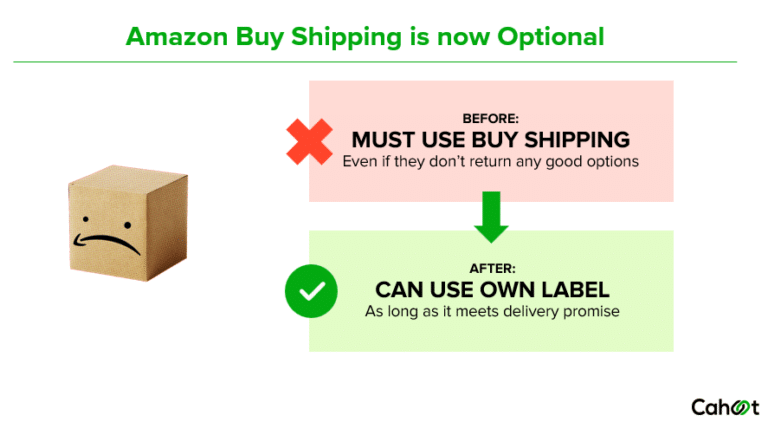
|
Old SFP Requirements
|
New SFP Requirements
|
Impact on Sellers
|
|---|---|---|
|
>99% Buy Shipping usage
|
No longer tracked
|
Positive
|
Previous Expectations
Buy Shipping usage is extremely important. Sellers must print nearly every label on Buy Shipping. Complying with program requirements boiled down to printing labels on Buy Shipping, and then ensuring carrier scans occurred on the same day.
New Expectations
Sellers will not be judged any longer by this metric – this is the biggest step Amazon claims it is taking to provide sellers and merchants “greater flexibility of shipping services and carriers”.
In return for being able to pick services off of Buy Shipping, a timely carrier scan will not suffice – the orders need to actually reach the customer within the Promised Delivery Date >93.5% of the time.
More flexibility in picking carriers and services
Amazon Buy Shipping has one major issue that numerous sellers have reported anecdotally. The platform does not do a good job of estimating the delivery speeds of USPS services. Buy Shipping sometimes excludes USPS services that are actually capable of meeting the delivery date, forcing the seller to pick a more expensive shipping label that it does believe is capable of reaching the customer in time. Buy Shipping also occasionally runs into errors, where it does not return a particular carrier for no particular reason. In all these cases, merchants are forced to buy labels off Buy Shipping, which reduces their usage less than the 99% bar.
With this requirement gone, sellers are now free to pick the ‘truly’ cheapest service. However, you can see the benefits of this only if you have an intelligent multi-carrier shipping software in place that rate-shops multiple carriers and shipping services to identify the truly cheapest label on each order.
Valid Tracking Rate (VTR)
Amazon provides its customers tracking numbers for them to be able to see where their order is at.
An order has valid tracking if it receives a first carrier scan (the scan that is performed by the carrier to indicate that the order is in transit).
Amazon defines the Valid Tracking Rate as Number of Prime packages with a Valid Tracking ID / Number of Prime packages for which shipment has been confirmed.
|
Old SFP Requirements
|
New SFP Requirements
|
Impact on Sellers
|
|---|---|---|
|
Not tracked currently
|
>99% – Amazon requires that the scan be made by an Amazon – integrated carrier.
|
Neutral
|
Previous Expectations
Sellers were not assessed on this metric.
New Expectations
Sellers are responsible for updating shipping carrier, shipping service and tracking number information on Amazon for each order, to enable customers to track the status of their packages.
Less Hassle for Merchants in Meeting This Metric
Amazon expects each package to have at least one carrier scan. This scan must occur before the customer receives their order, so that they can use the tracking number to see where their order is on Amazon. The fact that the carrier scan does not have to occur the same day is a positive for sellers. Many sellers have reported issues with carrier operations on the weekends – their packages are picked up, but no scans are actually conducted on a Saturday. Under the current program, this leads to violations of the OTS metric.
Under the new program, sellers should not face too many hurdles with getting packages scanned once before they reach customers.
Nationwide Delivery Coverage
This refers to the ability for products to be made available with fast shipping across the contiguous United States (the lower 48 states).
This expectation is based on the size tier that the item falls into (Standard Sized / Oversized / Extra Large).
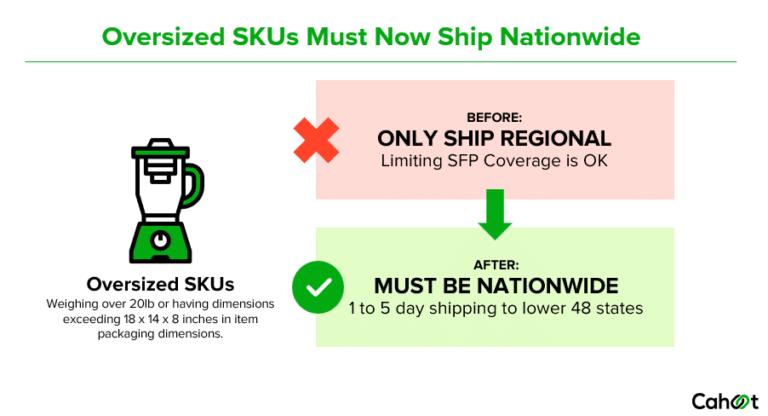
|
Old SFP Requirements
|
New SFP Requirements
|
Impact on Sellers
|
|---|---|---|
|
Only for Standard-sized Products
|
Expected for every SFP SKU, across all size tiers
|
Has Positives and Negatives
|
Previous Expectations
Standard-sized products must be made available within the entire contiguous U.S. on fast shipping.
Oversized items can be serviced within specific regions (also known as Regional SFP) – nationwide fast shipping is not required for them.
New Expectations
Products across all 3 of Amazon’s size tiers – Standard Sized, Oversized and Extra Large – must be made available in the contiguous U.S. on fast shipping.
Any product (regardless of size tier) that is configured with a Prime shipping template has a minimum delivery speed of 3-5 calendar days – sellers cannot edit this.
Looking for a New 3PL? Start with this Free RFP Template
Cut weeks off your selection process. Avoid pitfalls. Get the only 3PL RFP checklist built for ecommerce brands, absolutely free.
Get My Free 3PL RFPPrime Badge Available Nationwide For all SKUs, but with the Caveat of Higher Shipping Fees
Amazon is now willing to provide sellers the Prime badge nationwide on oversized and extra large SKUs, whereas previously it was restricted to just the specific regional part of the country the seller operated from. The metrics for 1- and 2-day delivery are not yet extremely high. This is on the whole a positive for sellers because the Prime badge boosts search rank, conversion and sales on these SKUs.
The negative is that the minimum delivery speed across every size tier is 3-5 days. This is a calendar-day based metric, which includes Sundays and Holidays. Therefore, it may not be possible to always use discount services capable of meeting the delivery timeline, such as USPS Priority Mail, FedEx Home or UPS Ground. In some cases, the seller might still be forced to use expensive air shipping.
Delivery Speed Metrics
Amazon tracks this based on the % of Product Detail page views that promise same-, 1- or 2-day delivery to customers.
This percentage will be calculated based on pageviews from customers across the entire contiguous United States, not just those in your defined regions for Same-, 1- or 2-day deliveries.
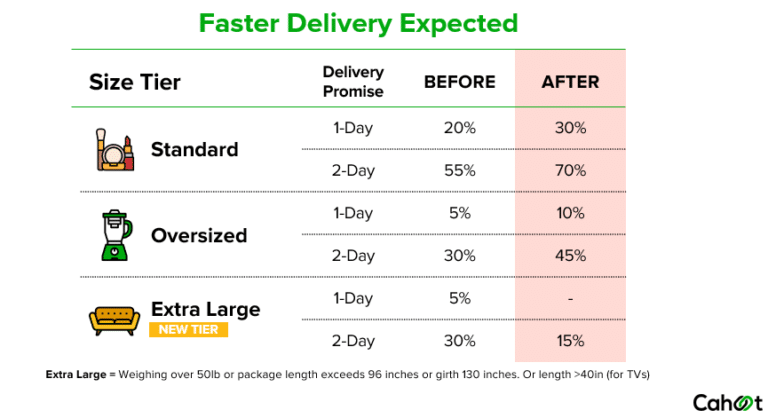
Previous Expectations
Amazon introduced the delivery speed metric as a percentage of product detail pageviews that promise customers same-, 1- or 2-day delivery.
The calculation is based on calendar days, and includes Sundays and holidays.
New Expectations
The delivery speed metrics across all size tiers have increased. They will now be based on pageviews from customers all over the lower 48 states, in addition to those in your defined regions for same-, 1- and 2-day deliveries.
Amazon has said that it does not have targets for Same-Day Deliveries initially.
However, as Amazon focuses on same-day deliveries for its inhouse FBA logistics network, there might be revisions to this in the coming months.
Delivery Speed Expectations Increase Across Every SKU

- This is how delivery promises will be displayed to customers (assuming a cut-off time of 2PM, and that you deliver every order within 1 day after it ships).
- These metrics have always been the most crucial and challenging for sellers to meet. Sometimes, they’ve been unfairly penalized for them also. Let’s say you’re based in New York, and a customer in Connecticut is browsing your product detail page at 6 PM ET. Even though you may be capable of delivering the package to them the next day, Amazon will still show only a 2-day delivery promise.
Achieving a high % of 1- and 2-day delivery pageviews nationwide is not easy, and relies largely on ensuring that your inventory is strategically distributed in a network of USA fulfillment centers so that customers from everywhere see fast shipping promises.
Trial Period
Sellers hoping to be a part of the SFP program must go through a trial period where they can prove to Amazon that they are capable of meeting the rigorous criteria of the program.
During this trial period, when customers shop their products, they will not see the Prime badge on the listings. On successfully completing the trial period and meeting the SFP criteria, Amazon will enable the Prime badge for the listings.
|
Old SFP Requirements
|
New SFP Requirements
|
Impact on Sellers
|
|---|---|---|
|
A short pre-trial process, followed by a 90 day trial where 200 orders have to be shipped, while meting all SFP criteria.
|
A 90 day pre-qualification process, followed by a 30 day trial where 100 orders have to be shipped, while meeting all SFP criteria.
|
Positive for Some, Negative for Others
|
Previous Expectations
Before the trial:
Have a Professional seller account, and activate Premium Shipping. Fulfill 30 Premium orders in 1 month.
During the trial:
Fulfill 200 orders in 90 days. Do so while meeting all requirements of the SFP program.
New Expectations
Products across all 3 of Amazon’s size tiers – Standard Sized, Oversized and Extra Large – must be made available in the contiguous U.S. on fast shipping.
Any product (regardless of size tier) that is configured with a Prime shipping template has a minimum delivery speed of 3-5 calendar days – sellers cannot edit this.
Time to Enrollment Shortens for Some Sellers, While Others May No Longer Be Eligible
Previously, the trial period was longer in length and order volumes – having to fulfill 200 orders in 90 days while meeting the program criteria. Now, if you’ve self-fulfilled 100 packages in the last 90 days (or under, say 60 days) – you can get on the shorter trial of 30 days. The overall time to Seller Fulfilled Prime enrollment is potentially shorter (if a merchant can move past pre-qualification quickly).
However, when comparing 200 packages in 90 days to 100 deliveries in 30 days, sellers are expected to ship nearly 50% more orders per month – this can exclude sellers with small monthly volumes who were previously eligible to participate in the program.
Performance Evaluation
Amazon periodically assesses how its SFP sellers are faring, and to check whether they are meeting the expectations set for them.
|
Old SFP Requirements
|
New SFP Requirements
|
Impact on Sellers
|
|---|---|---|
|
Tracked every 7 days, and every 30 days
|
Tracked every 7 days
|
No change
|
The evaluations that Amazon conducts on sellers continues to occur at the same cadence that it always has – sellers will not face anything new.
Amazon will begin tracking sellers against the new set of metrics beginning October 1, 2023.
Resolving Disputes
Needless to say, order fulfillment is complex and mistakes can occur. While merchants face no penalties for mistakes that FBA makes, sellers on Amazon SFP face severe penalties for issues with orders.
|
Old SFP Requirements
|
New SFP Requirements
|
Impact on Sellers
|
|---|---|---|
|
If a requirement is missed, Amazon will suspend SFP for you and require you to submit a Plan of Action.
|
If a requirement is missed 3 times, you lose SFP eligibility.
|
Positive (if your SFP Fulfillment Partner has responsive support)
|
Previous Expectations
The Plan of Action needs to explain why you slipped up, what specific steps you’re taking to fix the current situation and measures that will be put in place to ensure it does not repeat.
New Expectations
An email will be sent the first time a requirement is missed. The Prime badge will be “paused” the 2nd time you miss the same requirement. If you are sure the issue is fixed, you can restart the Prime badge. If you make it through four weeks without violating the same requirement after you restart the Prime badge, your account will be reset. If you do miss the same requirement the 3rd time, you will lose the Prime badge. If you go through the pre-qualification process, you can start an SFP trial again.
Amazon Gives Sellers More Chances, but the Road Back is Extremely Tough
Under the previous Seller Fulfilled Prime requirements, when Amazon found sellers missing a certain metric, it would suspend them from the program and require submission of a Plan of Action. This was harsh – a single mistake could lead to suspension of the Prime badge. This was exacerbated by the resolution process – it can take a long time for Amazon to get back, and if they deemed the Plan of Action not good enough, they could delay reinstatement on the program.
Now, sellers have 3 strikes per program requirement. Additionally, this gives a chance to sellers to dig into why they missed a metric and work with their fulfillment partner to ensure it does not repeat again. Sellers that have an SFP fulfillment partner with responsive, reliable customer support should not face too much trouble in ironing out their errors and continuing their participation in the program. However, if the 3 strikes do occur, then it is a long, long way back – sellers must begin all over again – right from the pre-qualification process.
Free Returns
When a customer wishes to return a Return-eligible Prime item, the sellers are in most cases required to pay for the cost of the return shipping label, and to provide the customer a full refund. In a small number of cases, the customer might be required to bear the cost of the shipping label – in these cases, a refund is provided after deducting the price of the label.
|
Old SFP Requirements
|
New SFP Requirements
|
Impact on Sellers
|
|---|---|---|
|
Sellers are required to bear the cost of the return shipping labels in all cases, EXCEPT certain Buyer reason codes.
|
For any return eligible item under 50 lb, the Seller must provide free returns – irrespective of the buyer / seller reason code.
|
Negative
|
Previous Expectations
When the return had these Buyer codes, sellers were exempt from bearing the cost of the return label:
- Accidental order
- Better price available
- No longer needed or wanted
- Performance or quality not adequate
- Incompatible or not useful for intended purpose
- Part not compatible with existing system
- Excessive installation or did not install
New Expectations
Sellers must bear the cost of the return shipping label even in the cases of the above-mentioned buyer reason codes.
Return Costs Rise for Sellers – Even When the Onus is on the Buyer
Previously, in certain cases, sellers could provide refunds after deducting the cost of the shipping label. Now, even in cases where the onus may lie on the buyer’s side, the seller must bear the cost of the return shipping label. This is an additional expense that they must bear, which was not the case previously.
Program Fees
|
Old SFP Requirements
|
New SFP Requirements
|
Impact on Sellers
|
|---|---|---|
|
Does not exist
|
No Fee (a charge was originally planned by Amazon and subsequently withdrawn)
|
No Impact
|
Amazon originally announced that they would charge sellers 2% of the unit price for every item shipped via Seller Fulfilled Prime, or a minimum of $0.25.
Amid growing scrutiny from regulators over anti-competitive practises, the company withdrew this fee for concerns over how sellers and officials would perceive such behavior. Amazon withdrew the fee a few days before September 26, 2023 when the Federal Trade Commission and 17 US states sued the company for anti-competitive behavior.
Amazon Resources
We hope you found our breakdown helpful and informative!
To read more about the old requirements that the program wanted sellers to meet, visit this page on Amazon Seller Central: https://sellercentral.amazon.com/help/hub/reference/external/G202072550
To read about the new requirements that Seller Fulfilled Prime will enforce starting October 1, 2023, visit this page on Seller Central:
https://sellercentral.amazon.com/help/hub/reference/external/GXCRLXHNJNPE2DHM
You can also read our guide to selling and winning on Amazon Seller fulfilled Prime to learn everything there is to know about SFP before you start the process in October 2023.

Turn Returns Into New Revenue
